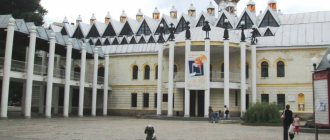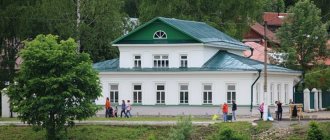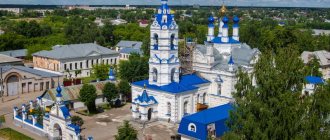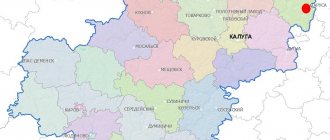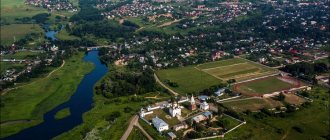Sometimes not only cities, but also towns become tourist centers. And not even resort ones. One of these phenomena is today at the junction of 3 regions - Ivanovo, Yaroslavl and Kostroma. It is the property of not only these regions, but of all of Russia. That’s why we call it respectfully – the city of Ples. The attractions of this place are associated with the authenticity of the natural and historical appearance (the location is located far from the “merciless wheels of civilization”), as well as the life and work of a whole galaxy of outstanding Russian artists. Plyos museums annually attract visitors - people have a keen interest in the events of the 19th century. Then the town played a more significant role. Curiosity stems from his history. So what is the best way to see the sights of Plyos? For those who like to leisurely wander around the city in the company of an expert guide, we have interesting excursions around Plyos for independent tourists, we have prepared our review.
Main attractions of Plyos
A visit to a patch of Russian land is an exploration of everything that is broadly called the Plyos Historical Reserve. The main share of glory was gained by the museums of Plyos and the foundations of the fortifications of the 12th century. As for the expositions specifically, not all of them were included in the top ten. Some are discussed in other chapters, but we will introduce you to them in full in a separate article. The second position is occupied by forest and coastal tracts of the area. By the way, about nature. If it weren’t for the local merchants, who at one time refused to build a noisy railway, Ples would have grown into a metropolis. Its infrastructure would simply erase all the charm that we enjoy during the local promenade. We are talking about untouched relict arboretums (through which quaint overgrown paths lead), forest edges, hills and a wide shallow at the mouth of the Shokhonka River. She gave the name to the village. After all, in Old Russian it means “a place where it splashes.”
Plyos State Museum-Reserve
As you guessed, you need to visit the main attractions of Plyos from an institution that will provide a complete list of them. Its name is given in the title. In the halls of the PGMZ, visitors discover the secret of the village’s origins, learn all its past achievements, as well as current brands. The exposition is located on Cathedral Hill. Its leadership, in fact, administers all historical ensembles. Guests of the city will immediately get acquainted with 7 branches of this center. We'll talk about some of them.
Sovetskaya Street (Shopping arcades, famous merchant estates)
While still a village (judging by ancient chronicles), Plyos was the same age as Moscow. Residential buildings from ancient times cannot be found. For example, we will not know in which hut (terem) the mayor Yakun Miroslavich was caught. This is the Novgorod “mayor” of the early 12th century. He fled from the angry population of the republic city that trusted him.
However, the 19th century is still well represented on the waterfront. It is worth mentioning the Sobolev House, popular among tourists, the Meat Trading Rows, the Vekshina Tea Room, the Groshev House and the Tretyakov estate with a bench. This refers to examples of “fiery” modernism.
Mount Levitan
It is quite natural that the main attractions of Plyos are visible from afar. A striking example of this is the hill located in the northeastern corner of the city, further than Zarechnaya Sloboda. We are talking about the best observation deck, the point from where the famous Isaac Ilyich (whose name was given to the hill) painted the most landscapes. Today, at the highest point of the ridge (30 m) there is a museum of wooden architecture. Few people remember that the mountain was previously named in honor of two kings - Peter and Paul.
Landscape Museum
The main attractions of Plyos can also be seen “in oil” (already in a frame). To do this, you just need to get to Lunacharsky, 20 (a couple of minutes walk from the center of the embankment). In addition to Levitan’s paintings, this exhibition hall exhibits paintings by Shishkin, Savrasov, Polenov and other Russian “earth-writers”.
Architecture of the Cathedral (Sobolinaya) Mountain and its foothills
The main attractions of Plyos are on Cathedral Hill and around it. The town was built from this very point. And this is noticeable in the remains of the fortress rampart. Let's start from the bottom. On Trade Square we will find the Church of the Resurrection of Christ. This lemon-gold building was built in honor of the Russian victories of 1812. On the eastern side of the hill, you cannot pass by the Assumption Cathedral, built back in 1699 (before it, a wooden analogue had stood here for 100 years). We are talking about the most striking example of Moscow Baroque. The Trinity and Vvedenskaya churches are visible at the southern foot of the mountain, best viewed from the local bus station. The first is “summer”, the most typical example of Russian Baroque (not to be confused with Moscow). It is typical for all cities of the Golden Ring. In the 17th century It was also made of wood and burned down. But the second one, having a similar fate, is 2 times smaller than its “sister”. The public places are an architectural masterpiece built in 1786. This is an elongated 2-story building of the district government (yes, yes, in the time of Catherine, the economically developed Plyos was awarded the title of district center).
Monument to Prince Vasily I
The sights of Plyos contain among their number a monument designed to preserve the memory of an important figure. We are talking about the prince, the first known ruler with the name Vasily. The heir of Dmitry Donskoy, who was taken hostage by the Tyumen Khan Tokhtamysh, is immortalized. Vasily is known for the fact that he later built a fortified outpost on the site of the village. The monument was erected near the Public Offices building. By the way, the son of this prince (Vasily the Dark) has already begun the full-fledged development of Sobolina Mountain.
Kalashnaya street
The sights of Plyos include its oldest street (named in the title). Where does this name come from? The fact is that the familiar expression “Kalash row” comes from the nickname of the shopping street where kalach makers sold their delicacies.
From a certain period, such rows became the first in bazaars. The city artery-monument is named after one of them. It is characterized by wooden buildings, which were completed mainly in the first years of the last century. The main element of the “Kalash” environment is the distinctive decoration of the facades. Here you will find platbands, end boards, cornices, light rooms, and mezzanines. The main “fabric” of the city “core” is outbuildings and outbuildings. The guides will tell you about barns, storehouses, cellars, sheds, mills and forges, as well as the characteristic fences of merchant estates and estates.
Ancient wooden architecture of the lower embankment
Those attractions of Plyos that are called its “business card” begin “from below”, from the river sandbanks. Here we see both the beauty created by God and the fruits of human efforts. Being in the “bottoms” is strange and very exciting for someone who grew up in a stone city. There are no strictly rectangular shapes here! There are traces of the author’s work everywhere, retaining the warmth of the builder’s hands. Go down the street. Yuryevskaya to the Volga!
Sweet mountain
While exploring the beautiful places of Plyos, take another journey into the world of nature and Orthodox religious architecture - go to the western outskirts. Here you will find green thickets consisting of alder and birch thickets, and the Church of the Transfiguration (with which your adventure should begin). By the way, the small cathedral has an interesting legend. The building was erected in 1849 on the site of a churchyard. This happened after some residents of the town found the rebels here... dead.
House-Museum of I. Levitan
“To the fullest” we will tell you about the building in Zarechnaya Sloboda (the eastern bank of the Shokhonka branch). It keeps a reminder of the life and work of the person thanks to whom Ples received the lion's share of its popularity. This “master of the brush” left a noticeable mark on the history of the development of Russian landscape. Talk about Isaac Levitan. His former home still carefully preserves his belongings.
Ples and Levitan
The artist first visited Plyos as a very young man, he was not yet 30 years old, and he fell in love with this lovely land and then lived here for several years. Many local landscapes are depicted on his canvases. And in the city itself there is now not only a museum named after the great artist, but also a hill named after the famous summer resident. They say that it was there that Levitan spent long hours making etudes and sketches from life, admiring the Volga and the surrounding expanses, trying to capture all the beauty on canvas. It's definitely worth coming up here. Isaac Ilyich chose the most beautiful view of the surrounding area.
The museum, located in the artist’s former apartment in a real merchant’s house, is also definitely worth a look. The exposition is small, you can calmly and carefully examine everything in an hour or a little more. Children of any age will find something interesting for themselves; personal impressions will be complemented by the guide’s story. In the halls of the gallery there are original paintings that Levitan created in these parts. Perhaps some landscapes will already be recognizable.
On the top floor, the artist’s living room has been preserved, with antique furniture and even a real easel on which an unfinished painting stands. The setting makes it easy to imagine not only the life of that time, but also the very atmosphere of creativity at the dacha where Levitan lived with his artist friends.
The most beautiful places in Plyos
Maybe you didn’t pay attention, but you have already seen the beautiful places of Plyos many times - on the canvases of outstanding painters, postage stamps, websites dedicated to art history, and even in two films - “Cruel Romance” and “Chinese Service”.
“Déjà vu” will begin with a walk along the embankment, clearly visible from the movie boat. There, a distraught Karandyshev (with a cry of “Well, don’t let anyone get you!”) shot Larisa Ogudalova (the novel “Dowry” by Ostrovsky).
In addition to those elements of the embankment landscape that we have already talked about, it is worth mentioning the monument to the Plyos cat, installed at the western end of Sovetskaya Street. This is a monument to a real-life pet named Mukha, who lived with the artist Vitaly Panchenko. There is also a “Dachnitsa” on the embankment - a lady on a bench. By the way, vocalist Ivan Chaliapin was also a summer resident of Plyos. This was pointed out by A. Chekhov.
However, the beautiful places of Plyos begin on the way from Privolzhsk (the local regional center). Note the widened Shokhonka channel (north of Spassky). You will find an ideal place for a picnic, fishing, plein air painting exercises and an artistic photo shoot. What is there! You can just take a swim.
How to get there
The easiest way is by car ; The road is good, on the way there are Vladimir, Suzdal, Ivanovo - you can relax and at the same time see these beautiful cities. The journey will take approximately 5-6 hours. It is worth remembering that on summer weekends and May holidays you will not be able to enter the city itself; you will have to park your car at the entrance.
Our method is BlaBlacar . We were very lucky: the day before departure, when I was ready to take the Lastochka to Ivanovo (this is the third option), I found a driver on the Bla-Bla straight to Ples! This is rare, but possible. We also went back with him, although we initially booked a car to Ivanovo, and from there to Moscow.
Bus. The bus to Plyos runs from the Shchelkovsky bus station, it takes 8 hours, but the time is extremely inconvenient, but the return departure is at 20.55, which is quite okay, especially in the fall - we met the sunset and were on our way.
"Martin" . The high-speed train “Lastochka” has recently been running to Ivanovo and back; the journey takes almost 4 hours, the departure time is very convenient both there and back. And from Ivanovo to Plyos a bus runs almost every hour, the travel time is 2 hours.
What to see in Plyos in one day
What to see in Plyos if fate has only thrown you in for a day? The route is simple. From the bus station, move (in an ascending spiral) along Cathedral Hill. Almost all the main attractions are here. Paid entrance only to the museum-reserve (like all similar institutions, it costs 150 rubles). Next, follow down to the right. Explore the mouth of the river, cross the bridge to Zarechnaya Sloboda (start exploring it from the Levitan house-museum, and end with a photo session against the backdrop of the wooden Ascension Church on top of the mountain of the same name). Then move to the bridge and move in the opposite direction - along the entire embankment (the objects of which we have described to you). Finish - inspection of the Plyos cat and the showroom of its former owner - V. Panchenko. Later, all that remains is to pick mushrooms and berries on Milaya Gora (that is, in the local forest).
So, now you know what you can see in historical Plyos, and at the same time in the natural recreation of this settlement. For a picnic, stock up on food and drinks, and for everything else - a good mood... Entertainment will not fit.
Artist in the Hidden City
The reach opened up to Levitan unexpectedly. The artist went on a trip along the Volga to find inspiration. He was accompanied by friends - Sofya Kuvshinnikova and Alexey Stepanov. After a trip to the bright and exotic Caucasus, the Volga seemed to him “dead and dreary.” In a letter to Chekhov, Levitan complained about stunted plants, monotonous landscapes and gray skies.
“We went to Ryazan, boarded a ship and set off down the Oka. We tried to stay in the village of Chulkovo, but didn’t get along there for a long time... Finally we got to Ples. He immediately charmed us, and we decided to stop,” his companion later recalled.
The artist lived in the house of the merchant Solodovnikov, where the Levitan House was later built. Early in the morning he went out into the open air, wandered for hours along the gentle slopes, and returned home only at dusk.
“Never before have I felt so strongly this divine something diffused in everything. It does not lend itself to reason or analysis, but is comprehended by love...” wrote Levitan.
Photo: Vladimir Smirnov / TASS
Chance gave Levitan an endless source of inspiration for landscapes. He lived in Plyos all summer and returned there for the next two years, devoting more than 200 canvases to these places. He was captivated by the modest nature of these places, called Plyos a hidden city and sought to convey this in his paintings.
Take, for example, the painting “Evening. Golden Reach". It’s just before sunset, rare trees lean towards the Volga, its water surface resembles liquid gold, and the horizon and domes merge together in a pale yellow haze. The feeling of inner silence and grace permeates almost all the works of Levitan’s “Plyos” period.
Views of Plyos are immortalized not only in paintings - the smallest city on the Volga has appeared in the frames of many famous films. In films, Ples got leading and episodic roles, but he was never himself in them. The city first appeared in films in 1938, in Vsevolod Pudovkin’s historical film “Minin and Pozharsky”, in the role of a rural area devastated by Polish invaders
In “Almost a Funny Story,” a two-part melodrama of 1977, Ples was Drevnegorsk, in “The Chinese Service” he is called Tsaritsyn, and in the television series “The Golden Calf” Ples appeared in the image of the fictional city of Arbatov.
What to see in Ples in 2 days
If you are puzzled by what to see in Plyos, it would not hurt you to make inquiries about this city in advance. And if you know for sure that you will spend at least two days here, make a schedule of upcoming excursions. And here we will help again! The schedule of the 1st day (as well as its excursion route) is outlined in the previous chapter. All museums and historical ensembles are located in Zarechnaya Sloboda, on Sobornaya Hill and the embankment.
What can you see in Plyos on the 2nd day? Dedicate it to active and entertaining leisure:
- go to the widest place of Shokhonki (Spasskoye village at the southern entrance);
- have fun in the park-museum “Russian Izba” (buffoons will perform for children);
- enjoy the show at the cheerful Chugunok restaurant (Friday and Saturday 250 rubles).
Why is Plyos attractive?
of Plyos itself
in relative proximity to the capital, on the right bank of the Volga - had a rather unique impact on the history of these places. We find the first mention of the city in the 12th century in the Novgorod Chronicle. It was founded much earlier. For a long time, there was an outpost here - the place is convenient, the Volga spills into a stretch (hence the name) and flows for a long time, without winding, which is why the area can be seen for many miles.
Then Prince Vasily, the son of Dmitry Dolgoruky, founded a fortress here. But in 1238, during the invasion of Batu, it was destroyed, but the city was not lost in history. This region has long become a haven for spirituality and creativity.
Many famous artists, poets, writers and politicians came here. This is the land of elders and saints. And it seems that more than others the city fell in love with Isaac Ilyich Levitan, who lived and worked here for a long time. The painting “Evening. Golden Reach”, written here, the artist immortalized the name of the ancient city.
What to see in Plyos with children
Maybe not as much as you, but seeing the city of Plyos will also be interesting for the children you took with you on your amazing Upper Volga trip. Let's start with active recreation, the plan of which we briefly outlined in the previous paragraph.
Seeing the city of Plyos does not mean walking only along a route associated with the distant (or Soviet) past. The tiny agglomeration is able to offer completely modern leisure, which your children are so missing. Here are a couple of establishments that all family vacationers should definitely check out:
- park-museum “Russian Izba” (kids can expect porridge and folk jokes from buffoons);
- complex of water attractions on the Upper Beach.
The first object will cost you 400 rubles (1 adult plus 1 child ticket). It is located at the beginning of the Mount Liberty Descent. Attractions cost (as in all cities) from 50 to 200 rubles. You will find them at the intersection of the street. Lenin with the Road to the Milovka Forest.
Further and further into the centuries
There are several art museums in the city, where you can admire beautiful creations created a century or two ago. But Ples gives you the opportunity to “go back in time” not only to a century or two, but also much further.
There is a wonderful place in it that does not leave any child indifferent. This is a museum of an ancient Russian family of the 13th century “Russian House”. Archaeological excavations have given everyone the opportunity to see the life of a Plyos artisan-jeweler and his family back in 1237.
The museum is interactive, which is especially interesting for young visitors. It gives you the opportunity to look even further into the history of the region, to get acquainted with its “youngest” years. And not just look at how people lived several centuries ago, but also try to work on ancient craft machines yourself. A potter's wheel or grain grinder is, of course, a real exotic thing for a modern person, so the opportunity to put them into action and see the whole process of turning a piece of clay into a jug or a handful of grains into flour is very interesting and educational, especially for a child.
Here you can try on ancient clothes and military equipment - chain mail, a helmet. Which boy would be indifferent to this opportunity? Don’t forget to take photos, here they turn out unusually realistic, because the surroundings fully correspond to the era of the costume.
You can supplement your knowledge about ancient life in the city’s museum and exhibition complex “Public Places”. In its vaulted white-stone halls you can see the most ancient traces of local civilization and its development, as well as almost 300 items from the famous Alabuga treasure. Rare antique jewelry is remarkably preserved.
Plyos city in winter
What if you get to see the city of Ples exclusively in the winter months! Do not despair. Wandering through the unique natural and architectural landscape is a great pleasure even in the cold season. The works of many photographers (even amateurs) prove that some local corners are more beautiful precisely in snowfall or cold. What wonderful sledding, skiing and snowboarding activities are there for kids? Come with your kids to Milaya Gora. However, now it is a whole ski resort. And they called him (sorry for the tautology!) very nicely - “Milovka”. Admission for adults from 20 to 45, for children - from 10 to 25 rubles. One day of instruction 1200 rub.
To get acquainted with each item from the list of “Attractions of Plyos” means to take a fascinating journey into Russian antiquity, enjoy the same views that inspired famous artists of the nineteenth century, and see three areas at once during a half-hour cruise on a boat. You will capture objects of Orthodox worship and “read” interesting pages of the biography of creative people.
6
Interesting things around
From the museum halls you will want to go out again and walk around the city. During this walk you can try to find all the monuments of Plyos. They are not official and cumbersome here, but small and very sincere.
The bust of Levitan, depicted with a palette in his hand, will allow children to see the artist at work and remember the features of his inspired face facing his beloved Volga. The sculpture “Summer Resident” is another attraction. Girls especially like her; everyone wants to sit next to the beauty in an old dress and pose for a photo as a souvenir. You can even find a small bronze cat on the embankment.
Where to stay
The city on the Volga has a large selection of accommodation for tourists: holiday homes, guest houses, and the private sector. It all depends on desire and capabilities, and on the number of guests. Prices “float” depending on the category of residential premises; on the embankment, prices are higher than in the private sector. In order not only to explore the ancient city , but also to understand how it “lives”, it is better to rent housing from the locals.
Cathedral of the Assumption of the Blessed Virgin Mary
This place is revered by Orthodox people around the world largely because of its history. The cathedral was founded in the 15th century and is currently the oldest church in the Ivanovo region. Originally there was a wooden building on this site. However, at the end of the 17th century it was destroyed by fire, thanks to which a stone structure was erected.
In the 18th century, the wooden Ilinskaya Church was attached to the cathedral, but in Soviet times it was destroyed. For many years, the Cathedral of the Assumption of the Blessed Virgin Mary was visited only by local residents and people from nearby villages, but in the middle of the last century, the temple became of interest to citizens throughout the country.
Cathedral of the Assumption of the Blessed Virgin Mary
